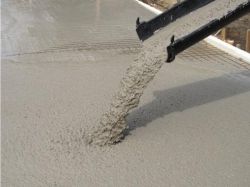The discoverers of natural concrete are rightly considered the Etruscan and the Romans who inherited this knowledge. However, this primacy is primarily due to the will of the case, according to which the volcanic rocks of suitable properties for concrete found themselves in Italy. Artificial concrete, kept its secret much longer.
Modern concrete and its history is not disconnected with the history of cement, since it is cement that is an integral part of concrete.
In the middle of the 18th century, it was noticed that a mixture of lime and clay with heat treatment gives small gray granules of high strength. These granules stick together and harden when mixed with water, and even in water! In 1796 the Englishman James Parker mixed lime and milled clay and burned at 900 degrees and got the first real concrete. He called it "romantsement" in honor of the Roman cement, which he tried to create.
However, concrete based on "romantsementa" turned out to be of poor quality. This was due to the need to raise the firing temperature to 1,450 - 1,500 degrees Celsius. However, the charcoal used at that time in England did not allow such a temperature to be obtained.
The world's discoverer of modern cement, and hence concrete, is considered to be American Joseph Aspdin. Which in 1824 received a patent for "portland cement", named after the place where the materials for the mixture were extracted. Joseph Aspdin used hard coal and was able to get a temperature of 1400 degrees, which is still considered sufficient to produce high-quality cement and concrete. Portland cement is today the main material from which concrete is made all over the world.
However, modern cement is made not less than at 1450 degrees and with a slightly modified recipe, and this recipe was discovered and proposed in 1844 by I. Johnson.
Also, it is not disputable that the concrete from cement was used already when Moscow was rebuilt in 1813. Russian architect-innovator Yegor Chelyev, supervised the reconstruction of a part of the buildings in Moscow and used lime-cured concrete already in 1913. And in 1822 he announced his invention of the silicate cement and published a book about the production of cement and concrete in 1825.
Iron-reinforced concrete (iron concrete), contrary to expectations, did not appear because of the needs of construction, but because of the needs of flower growers.
Каталог
Modern concrete - the history of creation
Технические характеристики





